Affective Drawing: enquiring into Place and a place
Rebecca Disney
“This is a room that matters, but that she was never quite part of.”[01]
“I think we are always searching for something hidden or merely potential or hypothetical following its traces whenever they appear on the surface.”[02]
When you sit in a room and read a book you are not looking at your environment, you perceive it, hear it, feel it; you sense its atmosphere and presence. Inadvertently you register the space that surrounds you. The representation of this intangible or unquantifiable quality is the aim and action of drawing: to engender a series of precarious encounters with things hidden, at the edge of perception.[03]
Drawing is a process of working with various ‘instruments’; found objects, film, and writing with,[04] to manifest the immanent thoughts and feelings that, as Lilian Chee recognises, “persistently haunt, or transmit.”[05] The works and workings presented here are concerned with exploring the sense of inbetweeness, of the dialogue – or, as Tim Ingold describes it, “correspondence”– which exists, unspoken or unseen between building and occupant.[06]
Intuition, unknowing and affect are at the core of this inquiry, exploring the importance of a tacit, situational and embodied “wisdom” as outlined by Juhani Pallasma, in which representation is “not solely a matter of recording the visual essence of the scene.”[07] It is a practice which examines what Mark Paterson defines as a “felt” phenomenology,[08] an affective and metaphorical form of touch, or what has been defined in the humanities as a “different kind of intelligence.”[09] Materials and haptic processes act as generators of thought, reliant upon and asserting that architects are “not so much uncertain experts, as experts in uncertainty.”[10]
The object of this enquiry is a 300-year-old dilapidated workshop, re-appropriated into a live-work space. its body a palimpsest of exposed, worn surfaces, its skin made up of peeling layers of paint and oil stains, its skeleton in need of repair.

01. Affective Reasoning drawing, the workshop building in its original state.
Thin pieces of window glass, treasured spolia, carefully removed and meticulously retained from the first floor of the building, rotting timbers, smudged mastic, dust, mould and associated miasmas. Found objects and sensations initiate a series of early drawings. Driven by these objects drawing is, as Michael Taussig observes, “a depicting,” and concurrently “a hauling, an unravelling and being impelled towards something.”[11]
The materiality of the found objects establishes a subtle contingency, inflected by echoes of their previous use and uses; scores made by lost hands, chips and errant cutouts blurring edges which were once clearly defined, putty overlaid with stained white mastic revealing ongoing maintenance or repair, scratches and distortions the archive of use. The residual marks borne by these objects are active participants in the drawing, inherently fragile but reverberating with utterances which fuel our perception of a place, opening both us and that place “to new possibilities of being,” prompting us “not to seek closure.”[12] They instil and install themselves in the drawer and drawing; drawing becomes an embodied process in which the observer and the thing observed are inextricably bound.
The drawings emerge from this process, formed of white and black paint, dark charcoal, fire grate polish, copper, lead sheet, sealant and casting silicone, all materials redolent within this space. These studies evoke textures of past occupancies, rhythms of actions which allude to absences. As though seen through clouded corneas, the drawings on glass become ludic assemblages constructed from traces, imagined actions and simple texts, etched across and through their surface. Letters drafted, but with no intention that they be sent,[13] voices written into the drawings. It is through these scripts, “through writing, as well as speaking” following Jane Rendell, “that thinking takes place.”[14] Written at various times, these writing-thinkings impart a melancholic quality to the glass-as-lens which is critical to the construction of the drawing. They impart a stillness, implying hidden meanings over time.
Part narrator, part lens, the glass substrates reveal fragments of the interior not usually seen, allowing us to re-witness the space: a paintbrush carelessly cleaned on the interior cladding, the leaching of rusty nails, their stains imprinted on the underside of beams suggesting water now absent, the minutiae of bitumen above empty sockets tracing the line where a flat roof had once been.
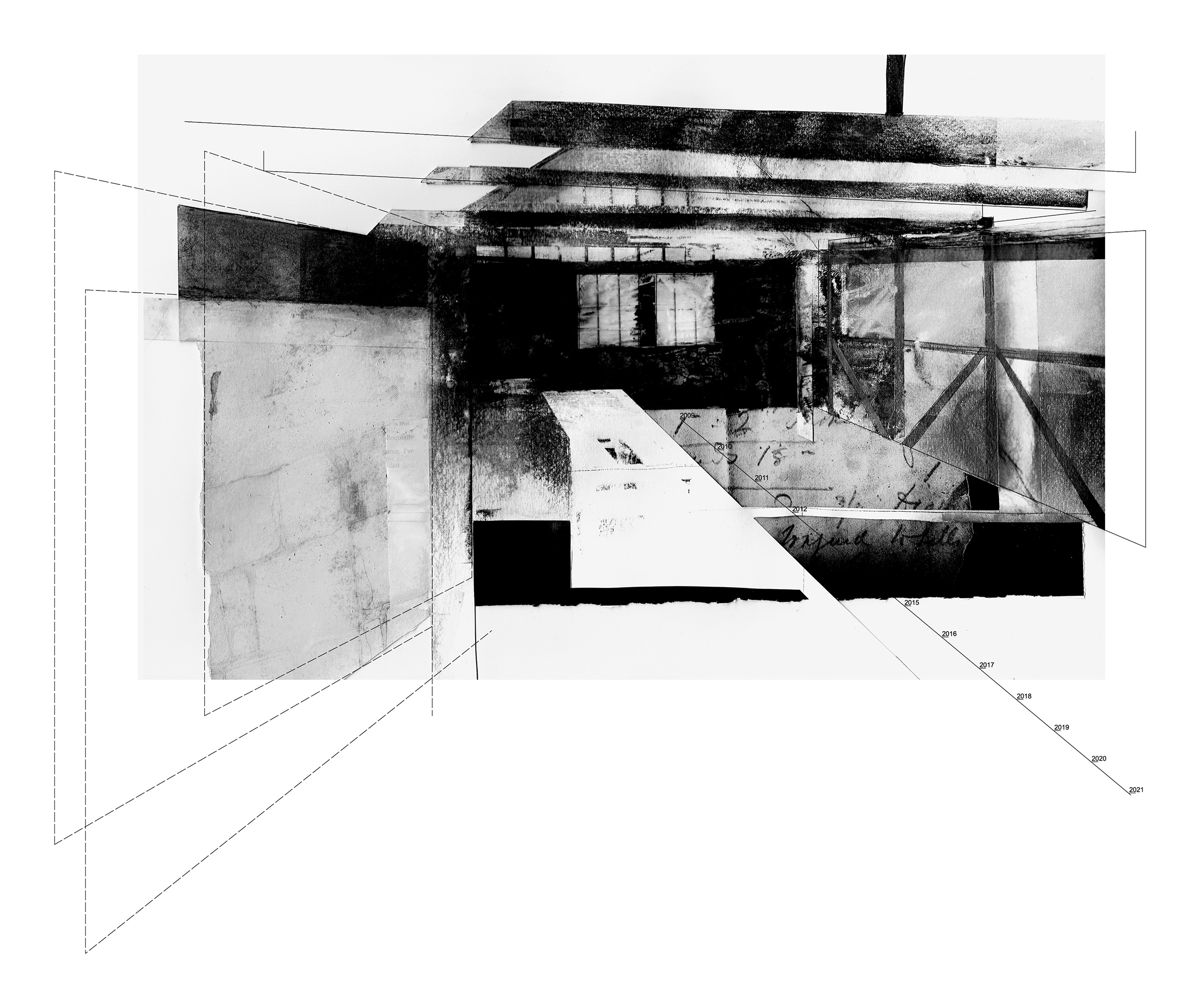
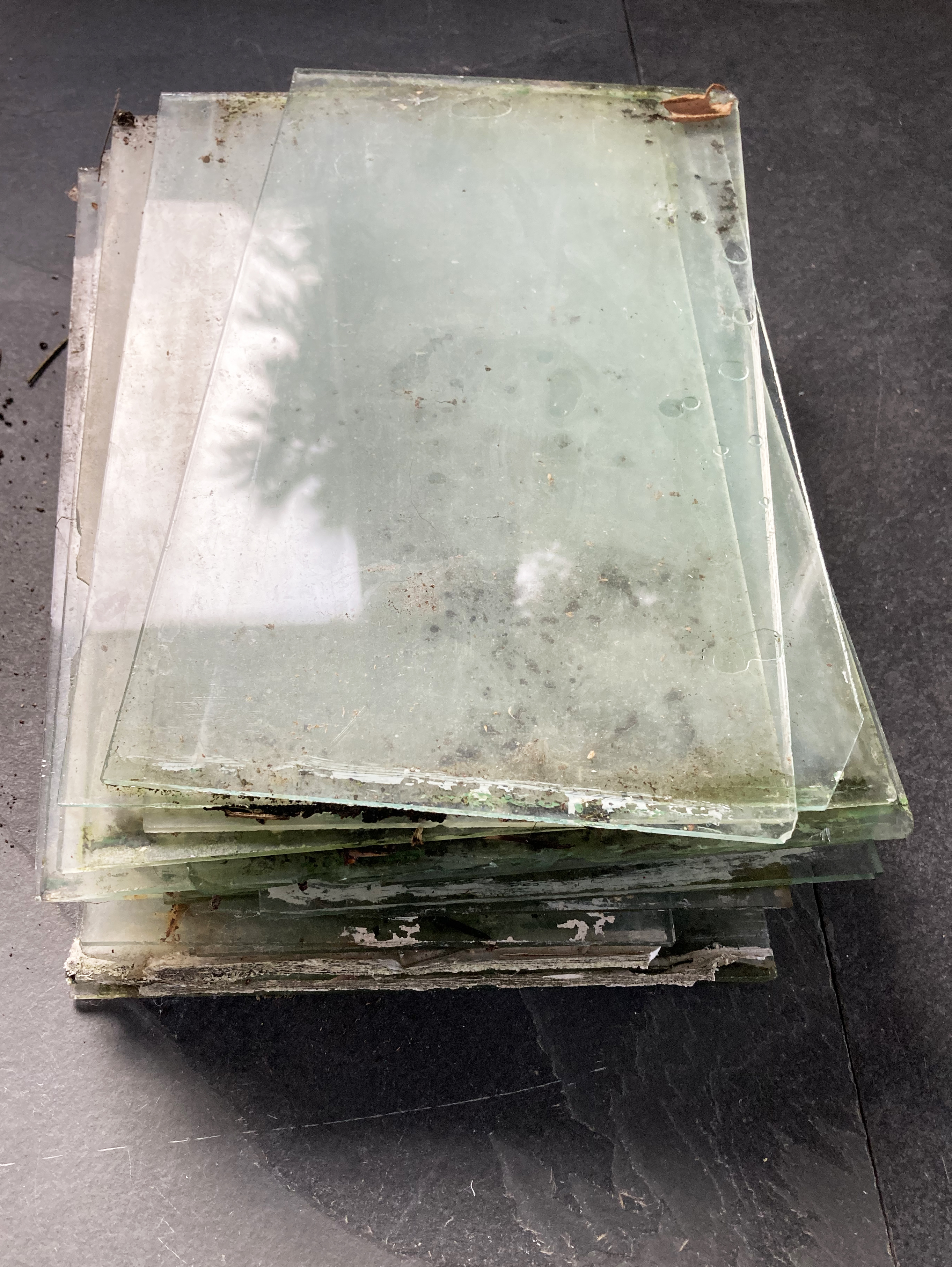
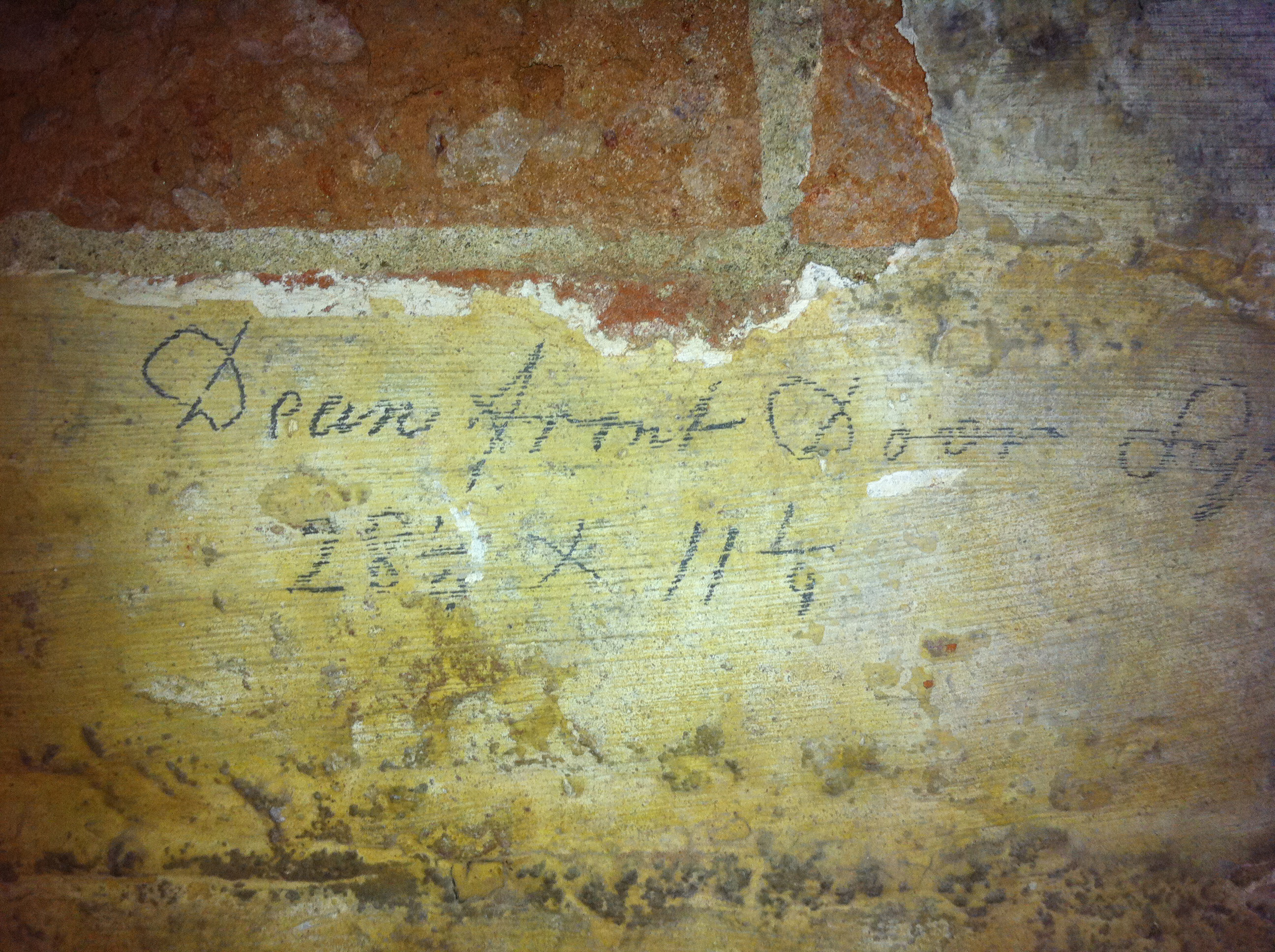
02. Affective Reasoning drawing, from the building in its original state, exploring the volume; Old panes of glass removed from the original building, retained for later use; As we cleaned other walls we uncovered handwritten notes on the plaster layers.brittle lantern
keep out the rain,the cold,
but let in the light,
large windows
the workman’s mantle.
Serendipitously, when lifted from their background in the drawing process these delicate panes reveal a fleeting projection, ephemeral images appear and disappear. At times, mirror-like through the application of black paint, reflections reveal distortions in the rafters above me. Beneath where I sit, the wooden floor is bone dry, it bears no wax, stain or varnish, its original sawn surface remains. Deep in the crevices between the boards reside unearthed stories caught in wood and cloth fibres. When did this debris last see daylight? Silicon casts of the floor, soft and pliable, extract these traces and, like a forensic examination of a skin, chart the scars, nicks, grazes, and bruises inscribed over time.
These transitory projections begin to imply a sense of time and motion. Drawing becomes animating. I pursue. Using simple tools – a digital scanner and iPhone – to separate hand from eye I set out to capture the “happenstantial quality” of these unintentional drawings.[15] In The Tactile Eye, Jennifer Barker establishes an embodied relationship between the medium of film and viewer, a “conduit of sorts…emerging in the intimate, tactile encounter between them.”[16] A film of the workshop develops. I lack the craft and experience to handle the implements professionally, to navigate with the dexterity of a filmmaker, to move as deftly; rather, the act of filming reveals the infant within. I become childlike in their presence, playful, exploratory, prepared to step into aberrant adventures.


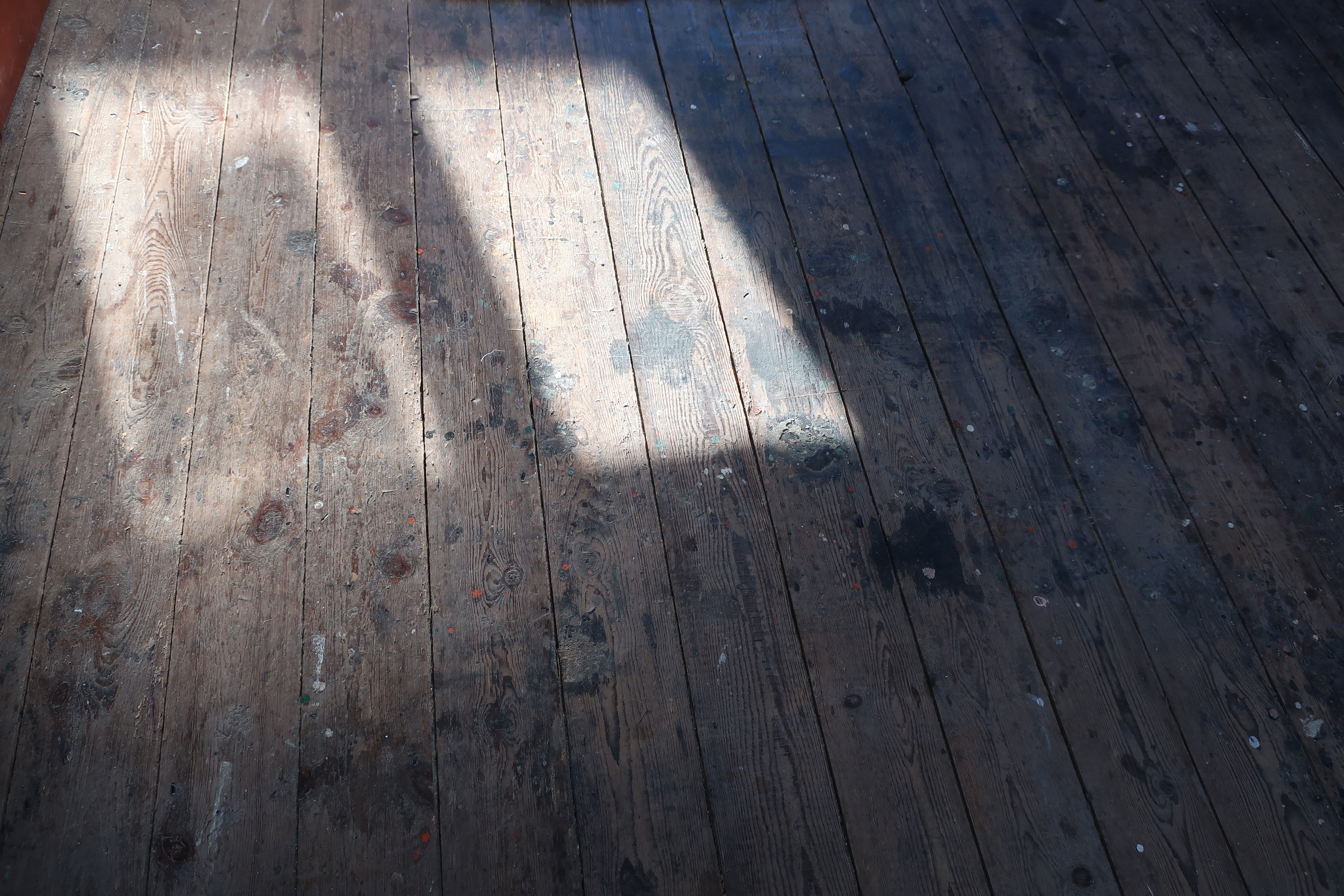
It is given.
It is to be followed.
whose hand made the stencil, the maker
knew others will follow.
The stencil is wood,
wafer thin,
a pin holds it up on the timber wall
wood on wood
and so, the timber boards up on timber studs.
The wall shows the past, stencil, paint, nails, screws.
Where hands from former makers leave
their traces, we go to.
03. Old letters uncovered in the rafters of the old workshop evidenced the lives of previous occupants; Rituals of preparation, a compendium of mark making implements; Morning light penetrating the plan and highlighting old stains and traces of use.
The digital scanner quickly encodes the building, in one sense an archaeological dig, inverted, into which any sequence or history is merged. The stone spine wall is captured, the rafters too, but not the roof. Slivers of textures, ciphers, glimpsed sections. Through the scans we acquire the capacity to peer through walls or witness obscure oblique views. Sequentially, I drift, and spin across the screen and through the space with ease.
At night, as darkness enfolds the building, these scans become projections, tripartite assemblages of scans and the initial drawings playing out through the laptop and an attendant projector. At this scale, these illuminated overlays are amplified, haptic voices speaking aloud. Akin to the architects’ iterative sketch on drafting paper, these fragmentary images become encrypted, an emotive coding seeking further enquiry and distillation. The blurred boundaries and edges are drawn, and redrawn, speculative and momentary collisions play out across the surface of the space.
The transient, indeterminable nature of affect prevails through these filmic sketches, inquisitive flirtations with probabilities and possibilities. The sense of proximity and then critical distancing which this process of drawing, filming, projection, and tracing creates is a sensation akin to the one experienced by Barker’s viewer, we are drawn “temporally, spatially, viscerally, and emotionally back and forth, toward and away.”[17] The momentary occupation of a surface – building, object or paper model – creates a ghostly presence, a luminescence, through which we are able to conjecture as to a possible past and presence. The drawing becomes a ‘brush’ clearing dust from buried bones so that we might re-imagine the body. The place becomes an unchartered territory, a novel landscape reconfigured through the skin of the projection, “transforming present realities and so providing glimpses of new future possibilities.”[18] Where in this fictitious world, might other territories exist?
A stone step
A threshold
Between
a place and a place.
The worn surface worn
a gentle hollow bearing feet through time
children’s socks and working boots.



To one side a peg,
A socket for the pin hinge,
From the pin
Scribed in stone, radiating rings like echoes emanating
from the original act
the door or gate, long gone
but traces left down the years.
04. Drawing from sketchbooks, mixed media; Tracing paper iterations; Detail from sketchbooks, mixed media.
Treading this liminal space, sitting somewhere between the conscious and the intuited, one walks a precarious and patient line. As Juhani Pallasmaa describes, we must proceed with the “uncertainty” that comes with “advancing on untrodden paths.”[19] It is in this advancing through “oblique knowledge” that we experience affect,[20] where – as framed by Lilian Chee – “the visceral and experiential exchanges that happen between subjects in encounters” is performed, “in a spatial setting.”[21]
These filmic ventures revealed to me an empathetic tie and a sense of belonging with the specifics and time of this place, cementing “a person’s being-in-the-world.”[22] In this place, creative acts find their bearings, a critical voice and agency emerges.
Where the exchange between building and occupant became most evident decisions about materiality and placement become charged. “In architectural dreaming, this wind, the pneumatic light of human imagination edifies our minds and visions of building.”[23] This sense of knowing when the drawing has reached its potential is felt and understood; in this moment drawings become “truly heuristic devises.”[24] Whilst this could imply a randomness and lack of critical judgement I do not believe this to be so. Actions are continuously set against accumulated knowledge, partiality attuned to the architects’ pen of reason and logic so heavily embedded within architectural training. As philosopher Brian Massumi outlines, this unknowing is a procedure for living, its “edginess comes because by this approach you are always in the middle of it, figuring it out as you go along.” Massumi describes it as a process in which there is “no way of knowing en route, let alone in advance, if it will work. Until it does.”[25]
In a talk given at the Cooper Gallery, Dundee University, Jane Rendell discussed her practice of Site Writing, outlining “certain things you cannot say,”[26] concluding that she was less fond of explaining and more interested in the ‘gaps’. Similarly, it is the ‘gaps’ in my practice which spur my enquiry. Whether, writing, scanning, projecting, filming, or editing, I pursue the things I cannot say, searching for a new comprehension of architectural space. This affective reasoning defies any succinct definition; it occupies a realm of “emergence, virtual, temporal.”[27] It requires a state of constant alertness, almost as if we should assume the role of a covert bystander, apparently disinterested but attentive and ready to act as prompts are given; the slightest lapse in concentration enables serendipitous clues to pass by undetected.
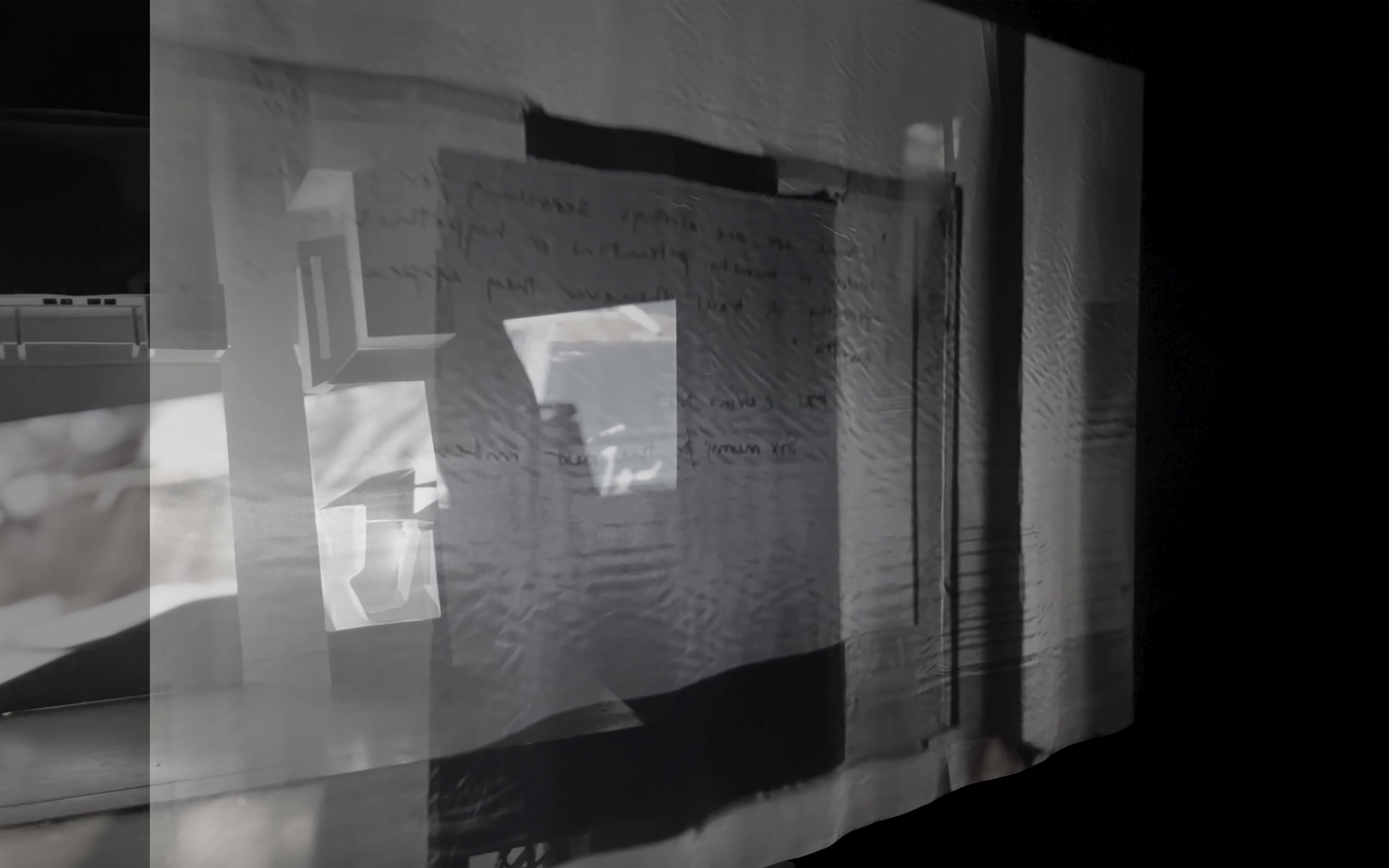

What do I see across the span of time
Old hands on new timbers turned to doors and windows
Old hands on tools guided by knowledge
Old hands, handing on skills in old rooms
Here at a new start we stand hearing old voices and adding ours to this buildings’s history,
History of labour
Guide my hand and influence my thoughts.
05. Filmic sketches: Meeting Point.
The collection of found object drawings has consolidated my understanding of Paterson’s premise that “touch can cement an empathic or affective bond, opening an entirely new channel of communication,”[28] and provide a means of detecting ineffable qualities, or the sensed dialogue between built space and inhabitant. The nascent films, whilst still embryonic, expose a fissure in space and time, and foreground “a form of empathy with the building.”[29] A new stratum overlays the building’s history, unveiling new latencies, tinctured “hollows and harbours in landscapes that shelter overlooked content and unforeseen possibilities.”[30] The workshop continues to infiltrate my thoughts; intimate and subjective; it is an “oneiric house.”[31] Paraphrasing Pallasmaa, over time I have set myself in that space and the space continues to settle in me.[32] It is through acts of drawing that we communicate.
Published 10th November, 2025.
Notes
Throughout this piece, moments of prose respond to the drawings produced. These words were written by Simon Lanyon-Hogg; they were prepared in the same workshop space as the drawings.
[01] Jane Rendell, “Everywhere Else.” The essay was published as a catalogue essay for artists Jan Peters, Martina Schmid, Silke Schatz, curated by Domo Baal Gallery, London (October 2003). It is available at https://www.janerendell.co.uk/wp-content/uploads/2009/03/elsewhere.pdf (Accessed 20th March 2025).
[02] Italo Calvino, Six Memos for the Next Millenium (Vintage Books, 1993), 77.
[03] Lilian Chee, Architecture and Affect: Precarious Spaces (Routledge, 2023). Reference is made here to Chee’s discussion in the introduction of her book to the precarious nature and definition of affect within architectural practice and theory.
[04] Jane Rendell, “Prologue,” in Site Writing: The Architecture of Art Criticism (I.B.Tauris & Co. Ltd. 2010), 6.
[05] Chee, Architecture and Affect. 6.
[06] Mark Patterson, The Senses of Touch: Haptics, Affects and Technologies (Berg Publishers, 2007), 3.
[07] Juhani Pallasmaa, The Thinking Hand: Existential and Embodied Wisdom in Architecture (John Wiley & Sons Ltd, 2009), 102.
[08] Patterson, The Senses of Touch, 6.
[09] Nigel Thrift, “Intensities of feeling: Towards a spatial politics of affect,” Geografiska Annaler: Series B, Human Geography, vol.86, no.1 (2004): 60. https://doi.org/10.1111/j.0435-3684.2004.00154.x
[10] Thomas Yarrow, Architects: Portraits of a Practice (Cornell University Press, 2019), 238.
[11] Michael Taussig, I Swear I Saw This: Drawings in Fieldwork Notebooks, Namely my Own (University of Chicago Press, 2011), xii.
[12] Tim Ingold, Making: Anthropology, Archaeology, Art and Architecture (Routledge, 2010), 11.
[13] When initially cleaning the site we uncovered old letters lodged in the rafters, including an inquiry for a replacement gate written in 1868, and measurements for a timber window frame hastily jotted down on a paper scrap in 1963.
[14] Jane Rendell, “Site-Writing,” transcript of a talk given at Building, Designing, Thinking, 3rd International Alvar Aalto Meeting on Modern Architecture, Alvar Aalto Akatemia Academy, Tiilimäki, Helsinki, Finland, (August 2008). https://www.janerendell.co.uk/wp-content/uploads/2013/02/Rendell-Site-Writing-PDF.pdf.
[15] Brian Massumi, Architectures of the Unforeseen: Essays in the Occurrent Arts (University of Minnesota Press, 2019), 157.
[16] Jennifer Lynde Barker, The Tactile Eye: Touch and the Cinematic Experience (University of California Press, 2009), 15.
[17] Barker, The Tactile Eye, 15.
[18] Jane Rendell, Art & Architecture A Place Between (I.B. Taurus. 2006), 83.
[19] Pallasmaa, The Thinking Hand, 72.
[20] Chee, Architecture and Affect, 20.
[21] Chee, Architecture and Affect, xv.
[22] Gernot Bohme, Atmospheric Architectures: The Aesthetics of Felt Spaces (Bloomsbury, 2017), 70.
[23] Marco Frascari, Eleven Exercises in the Art of Architectural Drawing: Slow Food for the Architect’s Imagination (Routledge, 2011), 141.
[24] Frascari, Eleven Exercises in the Art of Architectural Drawing, 68.
[25] Massumi, Architectures of the Unforeseen, 158.
[26] Jane Rendell “Site Writing: Transitional Spaces – textual and subjective – in montage constructions,” Lecture, Cooper Gallery, DJCAD University of Dundee, 7th October 2015. YouTube, https://www.youtube.com/watch?v=vnOkIHpGcf8.
[27] To list a few of the defining characteristics of affect as laid out by Chee. See Chee, Architecture and Affect, xv.
[28] Patterson, The Senses of Touch, 3.
[29] Penelope Haralambidou, “The architectural essay film,” Architectural Research Quarterly, vol.19, no.3 (2015): 247. https://doi.org/10.1017/S1359135515000524
[30] David Leatherbarrow, “Foreword,” in The Contested Territory of Architectural Theory, edited by Elie G. Haddad (Routledge, 2023), xxii.
[31] Gaston Bachelard, The Poetics of Space. (Beacon Press, 1994 (1969)), 15.
[32] Pallasmaa, The Thinking Hand, 104.
Figures
Banner.
Captured Glimpse.
01-05.
All of the drawings and photographs included in this piece were produced by the author.
https://doi.org/10.2218/b6bc2d27
